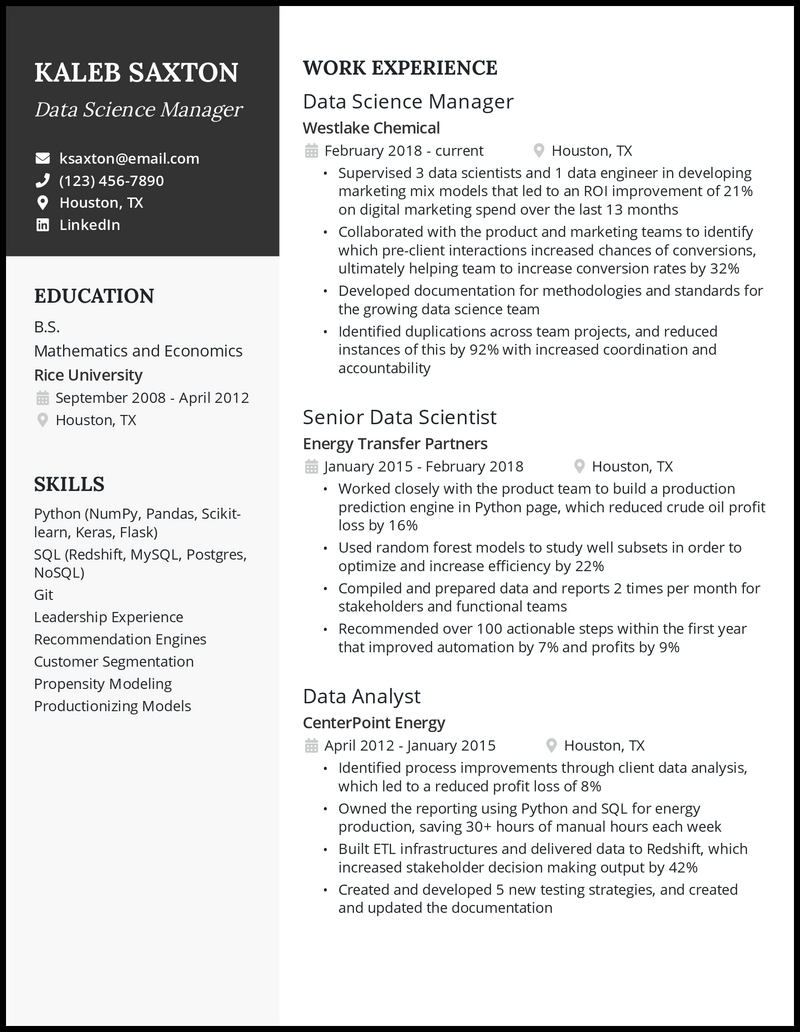Data Scientist Resume Guide
Introduction
Data science resumes are summaries of the education and work experience of data scientists and data science aspirants. The resume aims to present the candidate’s qualifications to potential employers and help secure lucrative professional opportunities. Since hiring managers typically just give resumes a cursory 30-second glance, your resume serves as their initial impression of you.
As a fresher in the field, it is very crucial to plan ahead and get ready before you start creating a data science resume because you do not have enough experience with the hiring processes. On the other hand, even senior data scientists should think and ensure that they include all relevant qualifications and work experiences.
To assist you in landing an ideal data science job, this blog briefs you about a few things to keep in mind before you draft a data science resume. We have also provided a data scientist resume sample for your reference.

Source: Madrid Software Trainings
Table of Contents
Key Elements of a Data Scientist Resume
There are certain key elements of a Data Scientist Resume. These are listed in the following section.
Resume Format for a Data Scientist: How to Choose a Resume Format?
There are three main resume formats to choose from when drafting your resume:
- Chronological Format
- Functional Format
- Hybrid Format
Your decision will be influenced by the level of industry expertise, whether you are transitioning from a comparable field, have had some time off, or have no prior experience in the field.
- Reverse Chronological Resumes: Reverse-chronological resumes are ideal for people with extensive and consistent experience in their area because these resumes list all relevant work experience in reverse chronological order.
- Functional Resumes: Functional resumes are suitable for inexperienced job searchers or people who are transitioning to the data science field. This kind of data scientist resume focuses on skills rather than work experiences.
- Hybrid Resumes: Hybrid resumes bring together the best of both worlds: They are suitable for both experienced and entry-level applicants and those from related businesses!
Essential Sections of a Data Scientist Resume
While crafting a Data Scientist resume, the following essential sections are to be considered.
Contact Information
Once the recruiter reviews your resume and shortlists you, they will contact you via the contact information you provide. Be very clear and prominent in specifying the section.
Include the following:
Name,
Email,
Address,
Phone Number,
LinkedIn (if valid) or GitHub profile.
Summary/Objective Statement
A Summary/Objective Statement is often the first section of a resume. Especially as a recent graduate with little professional experience, this section projects your career goals and objectives.
Here are a few points to consider when creating your career objective/summary:
- Use this section to tell your professional story using short paragraphs.
- Mention years of experience.
- Roles and responsibilities.
It is advisable to write this section last while creating your resume because it works like a summary of your data scientist resume. It should reflect what you are capable of for the specific job profile.
Education
Inevitably, recruiters expect you to mention your educational qualifications. A bachelor’s degree in computer science, statistics, or a related discipline is preferred for almost all data scientist jobs.
- Include all postsecondary degrees (such as college and graduate degrees)
- If you’re a recent graduate, you can include areas you studied that are relevant to the position.
Work Experience
It is not surprising anymore that work experience is more crucial than theoretical knowledge in the data science field. As a result, this is the most important section of your data scientist CV.
A data science resume for freshers should mention internships, personal projects, or open-source contributions.
- List your work history in reverse chronological order, with the most current work at the top and the others below.
- Indicate your job title, organization’s name, and work period.
- Describe your previous job roles in 1-2 lines.
- Show results; be sure to mention quantifiable results. For instance, you can mention, “I developed a production prediction engine in Python page that assisted in lowering the loss on crude oil profit by 22%.”
Technical Skills
The first person to read your resume is mostly a recruiter, who might not have the technical expertise to assess it. As a result, they often attempt to compare every data scientist CV to the job description to see whether the applicant possesses the required skills.
More recently, some businesses have also automated the screening process using an application tracking system (ATS). As a result, your resume must include the most appropriate skills that the job description calls for.
- You don’t need to include every skill you have. You can include the skills that the job description requires, for example, SQL, RDBMS, etc.
- If you stated something in the experience or summary/objective section, mention it again here.
Projects
A great way to highlight your skills is to give your hiring manager a glimpse of your projects. Consider the following when selecting which of your projects to list on your resume:
- Relevance: Even though you may have worked on several projects, the ones that are pertinent to the position you seek are the most valuable. Therefore, choose the top 2-3 projects you’ve completed.
- Exhibit Technical Mastery: You should provide a brief list of the tools, technologies, and methods you used to finish the project should also be included.
Certifications
If you have a certification or have taken an online course in data science or similar fields, list those as well. This is a great way to demonstrate your knowledge and expertise in the field.
Tips for Writing an Effective Data Scientist Resume
Now that you have a rough idea of what should a data scientist resume include, here are some tips that would help you in making your resume more precise.
Tailor Your Resume to the Job Description
Your data science CV objective should be where you start because it should match what the employer is looking for. The employer is seeking someone who can work with complicated datasets, do research, product analysis, forecasting, build, and prototype analysis pipelines.
Consider a scenario where an employer favors candidates with a Ph.D. in statistics. They might skim through resumes looking for the same keyword. Highlighting these keywords in your resume increases your chances of getting a data science interview.
Use Strong Action Verbs and Quantify Your Achievements
When describing your contributions to a team or project in your data scientist resume, use precise, concise action verbs that emphasize your accomplishments. The words “constructed,” “solved,” “accelerated,” “reduced,” and “launched” are examples of action verbs.
Instead of using general adjectives, use figures and important metrics to quantify your successes to demonstrate to potential employers the value you can offer their team.
Showcase Your Technical Skills
It’s a good idea to start by listing all your software and tool knowledge and data science expertise. You can include a few extra abilities that you feel are relevant, linked, or will make you stand out.
The following are some of the essential skills for data scientists:
Technical Skills:
Data analysis
Data modeling
A/B tests
Machine learning models
Regression
Data mining
Data tools and languages
R
Java
JavaScript
C
C++
C#
PHP
HTML
Highlight Your Experience with Data Analysis Tools
Another important factor on your data science resume is highlighting your experience with data analysis tools. Here are some examples:
- Hands-on experience with data visualization tools, including Matplotlib, Seaborn, ggplot2, and Plotly for creating interactive charts and plots.
- Knowledge of big data tools like Hadoop, Spark, and Hive for handling large-scale datasets.
Demonstrate Your Problem-solving Skills
The ability to recognize a problem, suggest solutions, choose the best one, and put it into action is referred to as problem-solving skills. The following is a list of abilities that could be useful at every stage of the problem-solving process.
Analytical Skills: You need to be able to look at a problem from several perspectives in order to solve it.
Research Skills: You must be able to locate and apply the appropriate tools, sift through the available information with sufficient depth, and locate the appropriate people to whom you may present your thoughts.
Critical Thinking Skills: If you have trouble seeing the larger picture, you won’t be able to weigh all the advantages and disadvantages, a vital part of critical thinking.
Crafting a Winning Data Scientist Resume
This section will walk you through a detailed guide to creating a winning data scientist resume.
Step-by-Step Guide to Writing a Data Scientist Resume
Step 1: Research the Job and Company
Researching the job and company for your data science resume is crucial to ensure that you are fully prepared for the selection process and can tailor your application to meet employer expectations. By studying the job description and the data science culture at the company, you can identify the specific skills, experiences, and qualifications the organization values most.
Moreover, understanding industry trends and challenges the organization faces enables you to showcase your problem-solving abilities and innovative mindset, vital qualities in a data scientist.
Step 2: Choose the Right Format
You should choose a relevant data science resume format.
The chronological resume structure should be appropriate unless your career is going in a new direction or is aimed toward consulting roles as an independent worker.
If you want to emphasize specific talents, clientele, or projects more than your previous employment, consider using a different resume structure. A functional or hybrid (combination) resume structure might be more appropriate.
Step 3: Write a Compelling Summary/Objective Statement
Your resume summary/objective briefly describes who you are and what, in terms of your career to date, is most significant to you to recruiters. You can highlight one or two of your biggest achievements while showcasing your professional personality and qualities in this concise narrative of three to five sentences.
Step 4: Highlight Your Relevant Education and Work Experience
Employers always search for a set of educational requirements rather than a single degree.
This is how to write a data scientist resume’s education section:
- Your highest degree or qualification should be first.
- Mention the city and the college, institution, or school in question.
- Mention academic accomplishments and coursework.
You must carefully prepare the work experience portion of your resume before jumping on a hyperplane and taking off for your desired job.
- Mention the company’s name, job position, and duration of employment.
- Write 4-6 bullet points outlining your responsibilities and achievements.
Step 5: Showcase Your Technical Skills and Projects
There is no denying the incredible knowledge of data scientists. However, including all of your knowledge in your resume is impossible.
Employers look for more than a fancy resume. They require people who are good at data science and also have other soft skills, like the ability to collaborate with others, solve problems, and think for themselves.
How to write the skills section of your resume for a data scientist:
- List your expertise in technical areas and data science.
- Compile a list of your strongest soft skills.
- Highlight qualifications.
- Use keywords from the job description.
Also write about projects as they make you more credible. They could be from your place of employment, capstone assignments from classes, or even weekend side projects that are acceptable.
Step 6: Include Relevant Certifications and Awards
It’s time to spice up your job application now that the primary resume part is complete. Recruiters examine hundreds of applicants for a single position in an effort to identify the one who stands out.
A degree is necessary to become a data scientist, but it is not sufficient. You should also have relevant certification in languages like Python, Java, etc.
Step 7: Proofread and Edit Your Resume
You must be meticulous and have excellent communication skills if you want to succeed as a data scientist. Proofreading your resume is one method to ensure that you have commendable written communication abilities.
Resume Examples for Data Scientists
In this section, we will look at some Data Scientist Resume Examples that will help you learn how to write a resume for a Data Science job in 2023.
Example 1: Entry-Level Data Scientist Resume

Source: Beamjobs
Example 2: Experienced Data Scientist Resume

Source: Beamjobs
Example 3: Data Science Manager Resume

Source: Beamjobs
Additional Tips for Crafting a Strong Data Scientist Resume
Some tips are discussed in the following section for you to help make your Data Scientist resume stand out.
Leveraging Your Network and Referrals
Networking is critical in the data science industry as it helps you to establish connections with the industry’s leaders and build a reputation for yourself in the industry. Any professional who wants to develop their career, expand their business, or positively impact their industry must have strong networking abilities.
Using Keywords and Action Verbs
Recruiters and hiring managers seek specific abilities, skills, expertise, and attributes in candidates, which are reflected in resume keywords and phrases. By including keywords in your resume, you can show the hiring manager that you are familiar with the industry and that you have a good understanding of the job requirements.
On the other hand, action words enable you to tell more with lesser words. Simply put, you can’t fit all you want to say to them on paper—leave some things for the interview. This is where action verbs aid in illustrating why you’re the best candidate.
Incorporating Industry-Specific Terminology
Incorporating industry-specific terminology in a data science resume is essential, as it demonstrates familiarity with the field and relevant concepts. This makes the candidate more attractive to potential employers, as an understanding of industry jargon and technical vocabulary indicates a strong foundation in data science principles.
Including Professional Development and Conferences
Including Professional Development and Conferences in a data science resume is essential as it showcases your commitment to staying current in the ever-evolving field of data science, highlights your eagerness to learn and adapt, and demonstrates networking abilities.
Examples of Professional Development activities:
- Enrolling in Online Courses or Certifications: Listing any completed online courses or certifications indicates your dedication to continuous learning and skill improvement.
- Attending Workshops and Seminars: Mentioning workshops and seminars you participated in portrays your interest in acquiring practical knowledge from experts in the field.
Common Mistakes to Avoid in a Data Scientist Resume
There are a few things that you should refrain from while drafting a winning data scientist resume. Read on to learn more.
Irrelevant or Outdated Information
Space is essential on your resume. Avoid wasting it on irrelevant or outdated information like
- Don’t add course numbers for related work.
- An empty GitHub profile. Make sure there are some genuine projects if you post them.
- Don’t list unnecessary skills on your resume.
Typos and Grammatical Errors
You must be meticulous in your job as a data scientist because poor grammar or terminology might work against you greatly. Any typos and grammatical errors on your resume can leave a negative impression on the recruiter.
Listing Duties Instead of Achievements
When creating a data science resume, it is important to focus on achievements rather than merely listing duties. This is because showcasing your accomplishments demonstrates your impact professionally and helps employers evaluate your potential value.
Listing Duties (example):
- Conducted data analysis using Python and R.
- Developed visualizations using Tableau and Power BI.
Focusing on Achievements (examples):
- Implemented a predictive model that increased sales conversion by 20% using Python and R.
- Enhanced data preprocessing pipeline, resulting in a 15% reduction in processing time for machine learning tasks.
Not Including Specific Technical Skills
Technical skills are crucial in the data science field, as they demonstrate your ability to work with complex tools, algorithms, and programming languages. Hence, make sure that you showcase all necessary hard skills.
Examples:
- A company may be searching for a data scientist with expertise in Python programming. If you have Python experience but fail to mention it on your resume, you might not be considered for the position.
- Big data tools such as Hadoop or Spark are often required in data science roles. By not listing them, you may skip opportunities as recruiters might pass on your resume.
Failing to Quantify Achievements
Another important part of a data science resume is to quantify your achievements. Quantifying your achievements is also a great way to show recruiters that you have the ability to drive results.
Examples:
- Developed a machine learning model that improved accuracy by 15% and reduced processing time by 25%.
- Analyzed 1TB of customer data and identified key behavior patterns that led to a 10% increase in sales.
Conclusion
Working with massive data and data sets, locating pertinent data, and making educated decisions and suggestions are all expected of you as a data scientist. Given the level of technical expertise required by a professional data scientist, it is a challenge for recruiters to hire ideal candidates.
You will be in a wonderful position to write a standout data science resume and cover letter if you approach to resume writing with the same mindset that you would when analyzing data.
To summarize what we have discussed thus far, be sure to write your resume using the following guidelines:
- Study the organization, the position, and any necessary data skills.
- To create a resume outline, use sample and template resumes as a guide.
- In the appropriate area of your CV, list your relevant schooling, employment history, and data projects. Emphasize any experience you have with machine learning and data technologies.
- Verify your Data Scientist resume’s language and spelling.
You can visit Analytics Vidhya (AV) to find out more guidance on data science, machine learning, and other related technologies like artificial intelligence as professional opportunities. AV is an excellent educational portal that serves as a one-stop destination for all learning resources and professional advice pertaining to ML, AI, and Data Science. To prepare you for a future focused on technology, they provide a vast array of blogs, courses, and a community of specialists.









